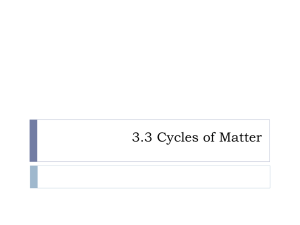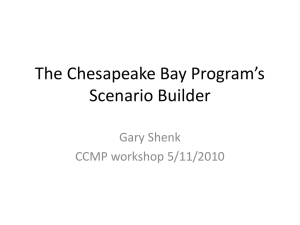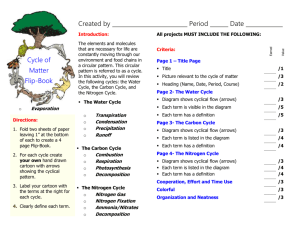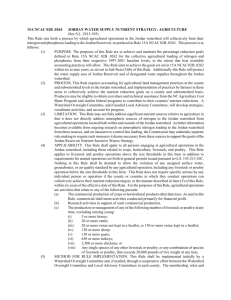Project Fact Sheet - The Conservation Registry
advertisement
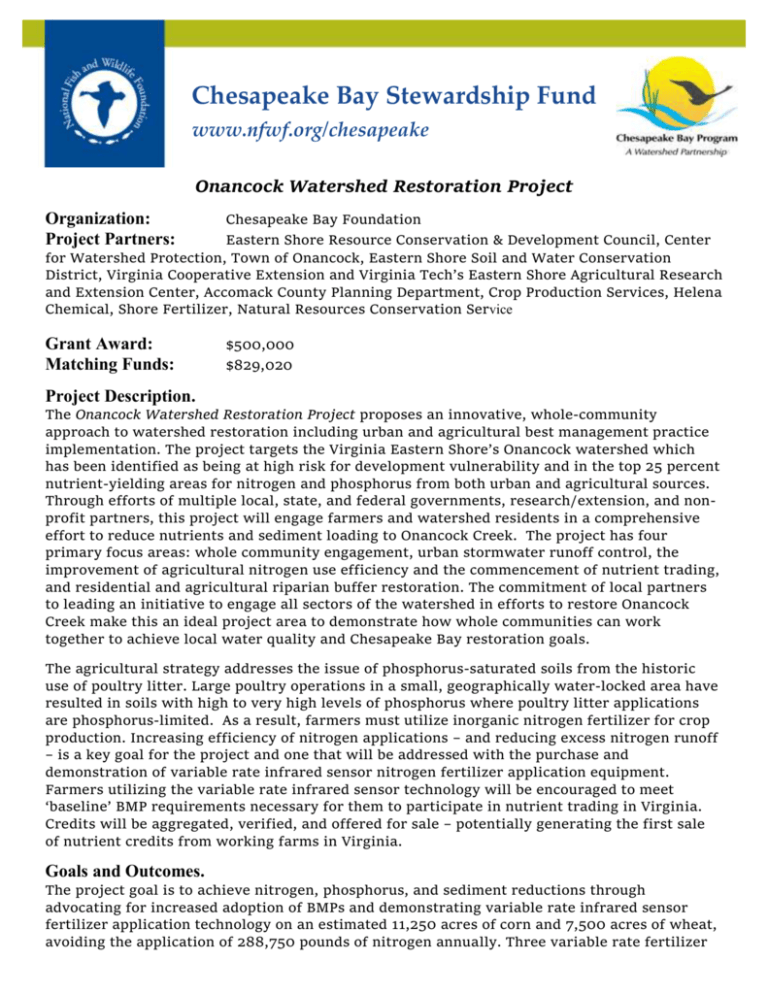
Chesapeake Bay Stewardship Fund www.nfwf.org/chesapeake Onancock Watershed Restoration Project Organization: Project Partners: Chesapeake Bay Foundation Eastern Shore Resource Conservation & Development Council, Center for Watershed Protection, Town of Onancock, Eastern Shore Soil and Water Conservation District, Virginia Cooperative Extension and Virginia Tech’s Eastern Shore Agricultural Research and Extension Center, Accomack County Planning Department, Crop Production Services, Helena Chemical, Shore Fertilizer, Natural Resources Conservation Service Grant Award: Matching Funds: $500,000 $829,020 Project Description. The Onancock Watershed Restoration Project proposes an innovative, whole-community approach to watershed restoration including urban and agricultural best management practice implementation. The project targets the Virginia Eastern Shore’s Onancock watershed which has been identified as being at high risk for development vulnerability and in the top 25 percent nutrient-yielding areas for nitrogen and phosphorus from both urban and agricultural sources. Through efforts of multiple local, state, and federal governments, research/extension, and nonprofit partners, this project will engage farmers and watershed residents in a comprehensive effort to reduce nutrients and sediment loading to Onancock Creek. The project has four primary focus areas: whole community engagement, urban stormwater runoff control, the improvement of agricultural nitrogen use efficiency and the commencement of nutrient trading, and residential and agricultural riparian buffer restoration. The commitment of local partners to leading an initiative to engage all sectors of the watershed in efforts to restore Onancock Creek make this an ideal project area to demonstrate how whole communities can work together to achieve local water quality and Chesapeake Bay restoration goals. The agricultural strategy addresses the issue of phosphorus-saturated soils from the historic use of poultry litter. Large poultry operations in a small, geographically water-locked area have resulted in soils with high to very high levels of phosphorus where poultry litter applications are phosphorus-limited. As a result, farmers must utilize inorganic nitrogen fertilizer for crop production. Increasing efficiency of nitrogen applications – and reducing excess nitrogen runoff – is a key goal for the project and one that will be addressed with the purchase and demonstration of variable rate infrared sensor nitrogen fertilizer application equipment. Farmers utilizing the variable rate infrared sensor technology will be encouraged to meet ‘baseline’ BMP requirements necessary for them to participate in nutrient trading in Virginia. Credits will be aggregated, verified, and offered for sale – potentially generating the first sale of nutrient credits from working farms in Virginia. Goals and Outcomes. The project goal is to achieve nitrogen, phosphorus, and sediment reductions through advocating for increased adoption of BMPs and demonstrating variable rate infrared sensor fertilizer application technology on an estimated 11,250 acres of corn and 7,500 acres of wheat, avoiding the application of 288,750 pounds of nitrogen annually. Three variable rate fertilizer units operating on the Eastern Shore in partnership with 130 participants (farmers and custom applicator technicians, as well as conservation agency staff) on 18,750 acres of cropland is estimated to reduce nitrogen application by 288,750 pounds, and prevent 15,630 pounds of nitrogen from entering the Chesapeake Bay. Further, the project will generate nitrogen reduction credits from working farm lands that will be available for sale through the Virginia nutrient trading program. At least two workshops with an estimated participation of 25 farmers per workshop will be held to discuss nutrient trading opportunities. Partners will work to identify interested farmers including efforts to bring farmers up to baseline so they can participate in the Virginia nutrient trading program. As such, it is estimated that this project will result in an additional: 1,000 acres of cover crops, 1,000 acres of cropland converted to conservation tillage, and 500 acres of additional cropland covered by an NMP. This increased BMP adoption is estimated to reduce nitrogen entering waterways by 7,316 pounds, phosphorus by 329 pounds, and sediment by 11.4 tons annually. Partners anticipate enrolling 1,500 acres of cropland in a nutrient trading program, resulting in approximately $24,990 in additional revenue (assuming $20 per pound of nitrogen), and 1,250 pounds of nitrogen credits for sale. Efforts to restore riparian buffers will be focused on both agricultural and residential areas. To promote the increased adoption of agricultural riparian buffers, partners will host at least one agricultural grass riparian buffer workshop to educate an estimated 50 participants on the economic and conservation benefits of native warm season grasses buffers. Partners will work with farmers to install 8,000 linear feet of riparian buffers of at least 35 feet on agricultural land. Because many ditches that drain agricultural and urban areas in the watershed function essentially as perennial or intermittent streams, directly discharging into tributaries of Onancock Creek, partners will work to demonstrate BMPs for ditch maintenance and water quality protection on an estimated 600 linear feet of agricultural drainage ditches. Partners will host at least one workshop on ditch maintenance BMPs with anticipated attendance at 40, with the goal of two counties/local jurisdictions adopting ditch maintenance BMPs. In addition to the agricultural component, the goal for the urban stormwater component of the project is to demonstrate stormwater runoff best management practices, and to demonstrate how a community can develop a plan for meeting watershed implementation goals in a manner that supports planned growth and engages the whole community in restoration efforts. The urban component of the project includes a combination of on-the-ground implementation, planning, and assessment to reduce stormwater runoff volume, nutrients, and sediment. Project partners will prepare a watershed stormwater assessment for the town of Onancock to evaluate options for BMPs, including estimated costs of implementation. Three high-profile urban stormwater BMPs will be demonstrated for treating urban stormwater runoff from impervious surfaces. A bioretention system and a wet swale will be designed and installed on the town’s two largest paved surfaces where stormwater currently drains directly to the Onancock Creek. Also, a stormwater treatment wetland will be constructed at a new community health center. Status. We have not begun work on this project yet. Challenges and Lessons Learned. Since we have not commenced project work, we have no challenges to report. Readiness for Scale Up. If widely adopted, the variable rate fertilizer technology demonstrated by this project has the potential to reduce nitrogen application to corn and wheat acreage on the Virginia Eastern Shore by approximately 770,000 pounds annually. We also anticipate that successful demonstration of the nutrient trading program could result in more farmers and communities participating in statewide trading. Post-project outcomes include the potential for 30,000 acres to be enrolled on the Eastern Shore with $499,800 in additional revenue and 25,000 pounds of nitrogen credits for sale. In addition, since this is a whole-community approach to reducing nutrient and sediment pollution in a watershed, it is designed to serve as a model for other communities and to catalyze conservation efforts in surrounding areas. For more information, contact: Kristen Hughes Evans Chesapeake Bay Foundation Development Council 804/780-1392 khughes@cbf.org www.cbf.org Jane Corson-Lassiter Eastern Shore Resource Conservation & 757/787-2786 jane.lassiter@va.usda.gov Dr. Mark Reiter VA Tech Agricultural Research and Extension Center (AREC) 757-414-0724 x16 mreiter@vt.edu


